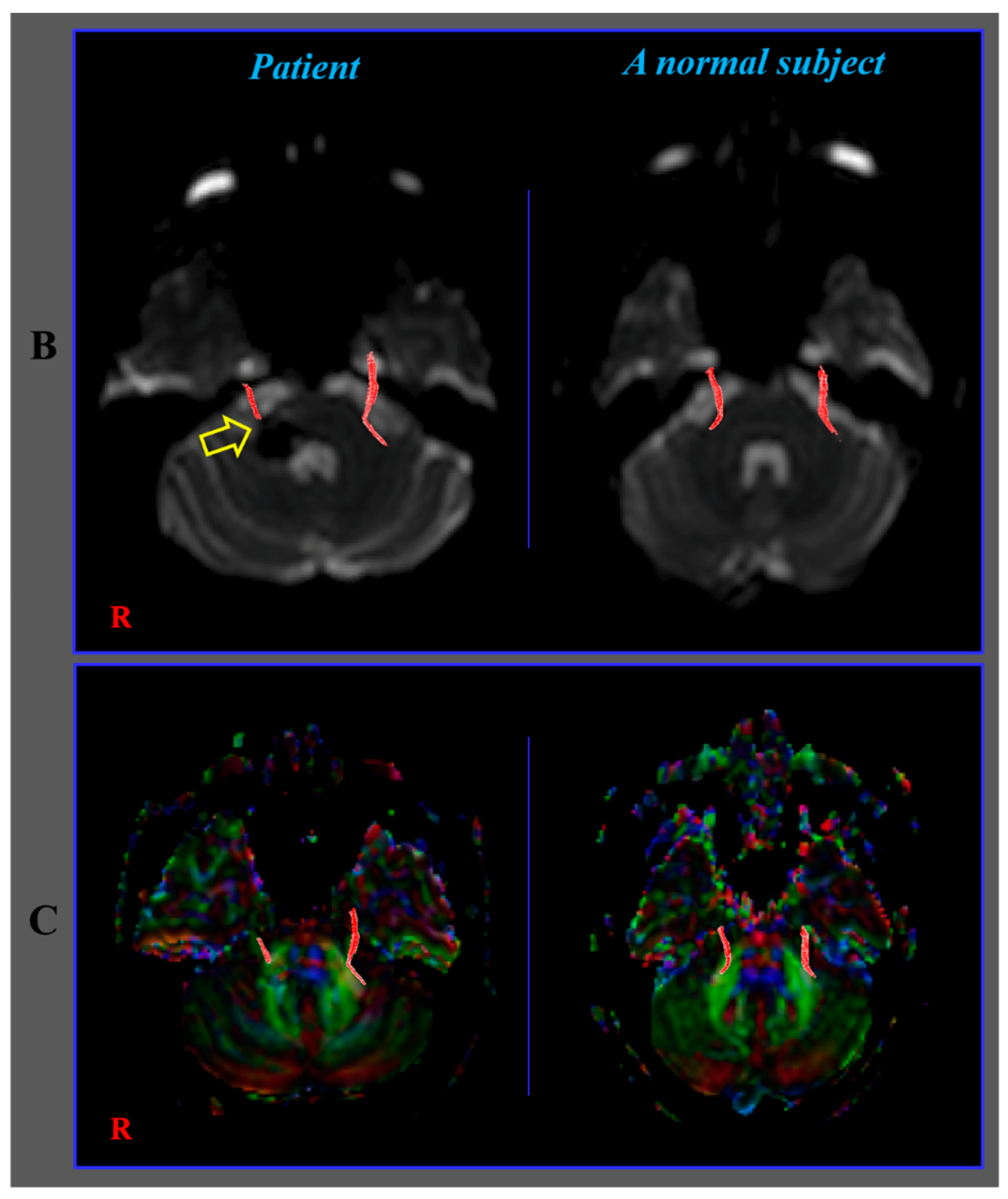Diagnosis of the Trigeminal Nerve Injury in a Patient with Pontine Hemorrhage
Abstract


Author Contributions
Funding
Conflicts of Interest
References
- Smith, S.M.; Jenkinson, M.; Woolrich, M.W.; Beckmann, C.F.; Behrens, T.E.; Johansen-Berg, H.; Bannister, P.R.; De Luca, M.; Drobnjak, I.; Flitney, D.E.; et al. Advances in functional and structural MR image analysis and implementation as FSL. Neuroimage 2004, 23 (Suppl. 1), S208–S219. [Google Scholar] [CrossRef] [PubMed]
- Kabasawa, H.; Masutani, Y.; Aoki, S.; Abe, O.; Masumoto, T.; Hayashi, N.; Ohtomo, K. 3T PROPELLER diffusion tensor fiber tractography: a feasibility study for cranial nerve fiber tracking. Radiat. Med. 2007, 25, 462–466. [Google Scholar] [CrossRef]
- Afifi, A.K.; Bergman, R.A. Functional Neuroanatomy: Text and Atlas, 2nd ed.; Lange Medical Books/McGraw-Hill: New York, NY, USA, 2005. [Google Scholar]
- DeSouza, D.D.; Davis, K.D.; Hodaie, M. Reversal of insular and microstructural nerve abnormalities following effective surgical treatment for trigeminal neuralgia. Pain 2015, 156, 1112–1123. [Google Scholar] [CrossRef]
- Lin, W.; Chen, Y.L.; Zhang, Q.W. Vascular compression of the trigeminal nerve in asymptomatic individuals: a voxel-wise analysis of axial and radial diffusivity. Acta Neurochir. 2014, 156, 577–580. [Google Scholar] [CrossRef]
- Hodaie, M.; Chen, D.Q.; Quan, J.; Laperriere, N. Tractography delineates microstructural changes in the trigeminal nerve after focal radiosurgery for trigeminal neuralgia. PLoS ONE 2012, 7, e32745. [Google Scholar] [CrossRef] [PubMed]
- Lummel, N.; Mehrkens, J.H.; Linn, J.; Buchholz, G.; Stahl, R.; Bochmann, K.; Bruckmann, H.; Lutz, J. Diffusion tensor imaging of the trigeminal nerve in patients with trigeminal neuralgia due to multiple sclerosis. Neuroradiology 2015, 57, 259–267. [Google Scholar] [CrossRef] [PubMed]
© 2020 by the authors. Licensee MDPI, Basel, Switzerland. This article is an open access article distributed under the terms and conditions of the Creative Commons Attribution (CC BY) license (http://creativecommons.org/licenses/by/4.0/).
Share and Cite
Choi, E.B.; Seo, J.P.; Jang, S.H. Diagnosis of the Trigeminal Nerve Injury in a Patient with Pontine Hemorrhage. Diagnostics 2020, 10, 74. https://doi.org/10.3390/diagnostics10020074
Choi EB, Seo JP, Jang SH. Diagnosis of the Trigeminal Nerve Injury in a Patient with Pontine Hemorrhage. Diagnostics. 2020; 10(2):74. https://doi.org/10.3390/diagnostics10020074
Chicago/Turabian StyleChoi, Eun Bi, Jeong Pyo Seo, and Sung Ho Jang. 2020. "Diagnosis of the Trigeminal Nerve Injury in a Patient with Pontine Hemorrhage" Diagnostics 10, no. 2: 74. https://doi.org/10.3390/diagnostics10020074
APA StyleChoi, E. B., Seo, J. P., & Jang, S. H. (2020). Diagnosis of the Trigeminal Nerve Injury in a Patient with Pontine Hemorrhage. Diagnostics, 10(2), 74. https://doi.org/10.3390/diagnostics10020074



